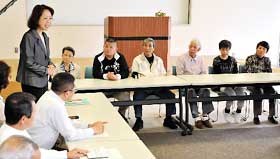A-bomb microcephaly Mental and physical disabilities from exposure in womb
When the United States dropped the atomic bombs on Hiroshima and Nagasaki, many babies were exposed to these weapons while in their mother's womb. As a result, a number of them came to be born with the disorder known as "A-bomb microcephaly." The cause of the condition was their exposure to high levels of radiation while in an early stage of development as an embryo. The size of the head is smaller for such patients, compared to ordinary people, and they often suffer from mental and physical disabilities. According to the Ministry of Health, Labor and Welfare, there are 22 patients with A-bomb microcephaly living in Japan as of the end of March 2011. They are known as "the youngest atomic bomb victims."
 |
| A meeting of the "Mushroom Club" was held in May 2011 with patients and family members in attendance. |
It took 20 years, after the bombings, for the existence of A-bomb microcephaly patients to become widely known. At first, the Atomic Bomb Casualty Commission (ABCC), now the Radiation Effects Research Foundation, told the patients' families that the disorder was caused by malnutrition during pregnancy, not by the atomic bombing.
In 1965, a group of writers and journalists called the "Hiroshima Research Group" published the book "Kono sekai no katasumi de" ("In One Corner of the World"), which brought the existence of microcephalic patients, who had long been left in shadow, out into the light. With this as inspiration, the patients and their families formed the "Mushroom Club" and began to lobby the government. Then, in 1967, the government finally admitted that their disorder was a consequence of the atomic bombings.
Microcephalic patients have suffered from the damage wrought by nuclear radiation from the time of their birth. While their ties to society are tenuous due to fears of prejudice and discrimination, they now face the problem of growing old and losing their parents. The government has a duty to strengthen the support measures for these individuals.
Issue 102 Girls' School of Hiroshima Electric Railway >>>